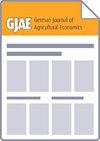农业用地生物多样性补偿供给曲线的发展——以斯图加特地区为例
IF 1.5
4区 经济学
Q4 AGRICULTURAL ECONOMICS & POLICY
引用次数: 2
摘要
根据欧洲各国不同的自然保护法案,对自然和景观的影响将被抵消。特别是在德国,生物多样性补偿也可以提前进行,例如,将其记入生态账户,然后将其分配给干预措施。在巴登-符腾堡州,这些抵消措施按照生态帐户条例(ÖKVO)以生态信用额进行评估。作为收入多样化的一种手段,农民可以在自己的土地上自愿实施抵消措施,然后产生和出售相应的生态信用。利用基于地理数据的模型,从经济角度分析了在耕地(具有主要生态信用潜力的地区)实施生物多样性补偿的潜力。斯图加特地区是德国西南部一个稳步发展的大都市。由于大规模建设措施导致的耕地流失和相关的补偿是这里的主要问题,因此它被作为研究区域。在分析中,种植作物的毛利率、它们的产量能力、相关的标准土地价值和可能抵消措施的成本被用来确定地块一级可耕地的净现值。从理论角度来看,根据生态信用的市场价格,在可耕地上采取抵消措施的可能性很大。生产一体化补偿(PIC)——一种耕地利用的扩大——在经济上不如将耕地转化为草地或将其用于自然保护更可行。斯图加特市和周边地区之间存在着巨大的空间差异。在斯图加特市,如果每个生态信用额度的价格低于1欧元,生物多样性抵消的实施在经济上是不可行的。相比之下,在周边地区,抵消措施可能在经济上是可行的,并以不到0.30欧元的价格大规模实施。这一点尤其重要,因为有关地区与斯图加特市位于同一自然地区,因此,如果采取干预措施,就可以获得生态信用。根据导出的供给曲线,决策者可以看到在空间受限的区域实施生物多样性抵消措施的额外成本规模。本文提出的分析可以帮助决策者更容易地权衡所需的自然特征和农业用地的经济效应。本文章由计算机程序翻译,如有差异,请以英文原文为准。
Development of Supply Curves for Biodiversity Offsets on Agricultural Land – a Case Study from the Stuttgart Region
Impacts on nature and landscape are to be offset in accordance with different nature conservation acts in various European countries. In Germany in particular, biodiversity offsets can also be made in advance, for instance, by booking them into eco-accounts, and then allocating them to an intervention. In Baden-Württemberg, these offset measures are assessed in eco credits in accordance with the Eco Account Regulation (ÖKVO). As a means of income diversification, farmers can voluntarily implement offset measures on their land, and then generate and sell corresponding eco credits. Using a geodata-based model, the potential for implementing biodiversity offsets on arable land – areas with major eco credit potential – is analysed from an economic perspective. The Stuttgart Region is a steadily growing conurbation in south-west Germany. It serves as a study region since the loss of farmland due to large-scale construction measures and the related offsetting are a major issue here. In the analysis, the gross margins of the crops grown, their yield capacity, the associated standard land values and the costs of possible offset measures are used to determine the net present value of the arable land at parcel level. From a theoretical point of view and depending on the market price for eco credits, there is a significant potential for offset measures on arable land. Production-integrated compensation (PIC) – an extensification of arable land use – is less economically viable than the conversion of arable land into grassland or its utilisation for nature conservation. There are major spatial disparities between the city of Stuttgart and the surrounding districts. The implementation of biodiversity offsets is not economically viable at a price of less than € 1.00 per eco credit in the city of Stuttgart. By contrast, in surrounding districts, offset measures may be economically viable and implemented on a large scale for less than € 0.30. This is particularly relevant as the districts concerned are located in the same natural area as the city of Stuttgart and the eco credits can, therefore, be attributed in the event of interventions. Based on derived supply curves, decision-makers can see the scale of additional costs of biodiversity offset measures if they are implemented in a spatially restricted region. The analyses presented here can help decision-makers to more easily weigh up the desired natural characteristics and economic effects in the context of agricultural land.
求助全文
通过发布文献求助,成功后即可免费获取论文全文。
去求助
来源期刊

German Journal of Agricultural Economics
AGRICULTURAL ECONOMICS & POLICY-
CiteScore
1.60
自引率
20.00%
发文量
0
期刊介绍:
The GJAE publishes a broad range of theoretical, applied and policy-related articles. It aims for a balanced coverage of economic issues within agricultural and food production, demand and trade, rural development, and sustainable and efficient resource use as well as specific German or European issues. The GJAE also welcomes review articles.
 求助内容:
求助内容: 应助结果提醒方式:
应助结果提醒方式:


